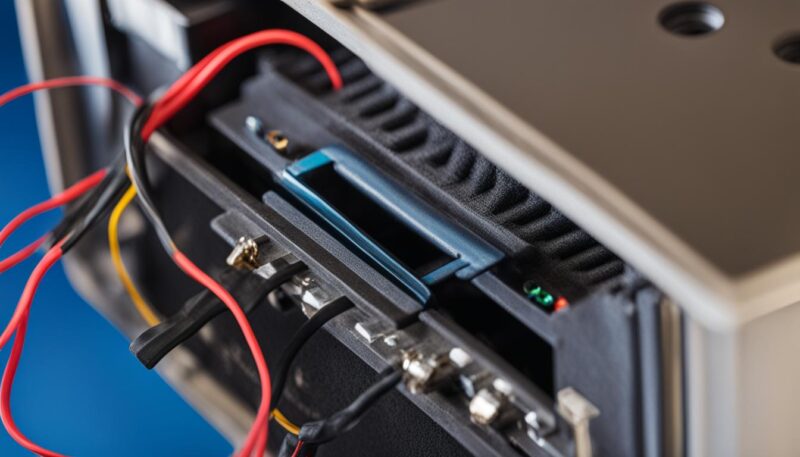Enhancing Your Cable Connection Speed
Having a strong and efficient cable connection is essential for enhancing your audio experience. By choosing the right speakers cable connection and ensuring proper installation, you can achieve superior sound quality.
Here are some tips to help you optimize your cable connection speed and elevate your audio experience.

Choosing the Right Speaker Cable Type
When it comes to speaker cables, there are different types to choose from. Consider the gauge, length, and impedance of the cables to ensure compatibility with your audio system. High-quality speaker cables with thicker gauges and lower resistance can provide better signal transmission and reduce signal loss, resulting in improved sound quality. Research different speaker cable options and choose the one that best suits your audio needs.
Here are some key factors to consider when selecting the right speaker cable type:
- Gauge: The gauge of the speaker cable determines its thickness. Thicker gauge cables, such as 12 or 14 gauge, can handle more power and provide better signal transmission compared to thinner cables. This can result in clearer and more accurate sound reproduction.
- Length: The length of the speaker cable can influence signal loss and degradation. Longer cable lengths can lead to increased resistance and impedance, affecting sound quality. It’s important to choose the appropriate cable length based on the distance between your speakers and audio source.
- Impedance: Speaker cable impedance refers to the resistance of the cables to the flow of electrical current. It’s crucial to match the impedance of your speaker cables with your audio equipment for efficient power transfer and optimal audio performance.
Choosing the Right Speaker Cable Gauge and Length
When selecting the gauge and length of your speaker cables, consider the following:
- Distance: Measure the distance from your audio source to your speakers to determine the cable length required.
- Power requirements: Consider the power requirements of your speakers and audio system. Higher-powered systems may benefit from thicker gauge cables.
- Compatibility: Ensure your speaker cables are compatible with your audio equipment and connectors.
By taking these factors into account, you can make an informed decision to select the right speaker cable gauge and length for your setup.
| Gauge | Resistance | Recommended Use |
|---|---|---|
| 12 | Low resistance | Ideal for long distances or high-powered systems. |
| 14 | Medium resistance | Good for average-length cable runs and general audio setups. |
| 16 | Higher resistance | Suitable for short cable runs in low-powered setups. |
Remember, selecting the appropriate speaker cable gauge and length is crucial for maintaining signal integrity and ensuring optimal audio performance.
Why Impedance Matching Matters
Matching the impedance of your speaker cables with your speakers and amplifiers/receivers is essential for a smooth audio experience. Most speakers and amplifiers/receivers come with a specific impedance rating, typically measured in ohms (Ω).
Common impedance ratings include 4 ohms and 8 ohms. Matching the impedance ratings ensures efficient power transfer between your audio components, reducing the risk of signal degradation and maximizing audio quality.
When the impedance of your speaker cables is mismatched with your audio equipment, it can result in various issues. If the speaker cables have higher impedance than the recommended rating, it may strain your amplifier/receiver, causing it to work harder and potentially leading to distorted sound or even damage to the equipment.
On the other hand, using speaker cables with lower impedance than required may overload your speakers, causing them to produce poor sound quality or overheat.
When selecting speaker cables, ensure that they have the appropriate impedance rating to match your audio equipment. Look for cables that clearly indicate their impedance compatibility. High-quality speaker cables often provide detailed specifications, including impedance ratings, on their packaging or official product documentation.
Types of Speaker Cables
There are various types of speaker cables available, each with its own characteristics and advantages. Here are some popular speaker cable types:
- Twisted Pair: Twisted pair speaker cables consist of two conductors that are twisted together. This design helps minimize electromagnetic interference and signal degradation. Twisted pair cables are widely used for both residential and professional audio setups.
- Oxygen-Free Copper (OFC): OFC speaker cables are made from high-purity copper with minimal oxygen content. This construction reduces the risk of oxidation over time, ensuring long-term reliability and improved signal transmission.
- Bi-Wire/Bi-Amp: Bi-wire or bi-amp speaker cables have separate conductors for the high-frequency and low-frequency signals. This design allows for better separation of the audio frequencies and can result in enhanced sound clarity and detail.
Remember, the choice of speaker cable type depends on your specific audio setup and preferences. Consulting with audio professionals or enthusiasts can help you make an informed decision based on your unique requirements.
Proper Speaker Wire Connections
Properly connecting your speakers with cables is crucial for achieving optimal audio performance. To ensure a seamless connection, it is important to match the positive and negative terminals on both the speakers and the amplifier/receiver.
Use high-quality speaker cable connectors such as banana plugs, spade connectors, or bare wire connections to create a secure and reliable linkage. These connectors not only provide a stable connection but also facilitate easy installation and maintenance.
| Speaker Cable Connector | Description |
|---|---|
| Banana Plugs | These connectors feature a banana-shaped design that allows for quick and easy insertion into compatible terminals. Banana plugs provide a secure connection and are widely used in home theater and audio systems. |
| Spade Connectors | Spade connectors have a flat metal or fork-shaped design that provides a strong connection by securely attaching to binding posts or terminals. They are durable and ideal for applications that require a fixed connection. |
| Bare Wire Connections | Using bare wire connections involves stripping the insulation from the speaker wire and directly inserting the exposed wire into the binding posts or terminals. While this method requires more effort, it offers a direct and solid connection for superior audio performance. |
Follow the manufacturer’s instructions for the correct wiring configuration based on your specific audio setup. This ensures that you establish the proper polarity and maintain the integrity of the signal throughout the entire system.
Avoid any loose or frayed connections as they can lead to signal loss or interference, impacting the overall sound quality. Regularly inspect your speaker wire connections and replace any damaged cables or connectors to maintain optimal performance.
Remember, a proper speaker wire connection is the foundation of great audio. Take the time to connect your speakers correctly and enjoy a rich and immersive sound experience.

Conclusion
Remember that the quality of your audio experience is not solely determined by your audio equipment but also by your cable connections. By following the recommended guidelines and taking the necessary steps to optimize your cable connection speed, you can elevate your audio experience to new heights.
So, don’t overlook the importance of properly selecting and installing your speaker cables. Experience the difference and enjoy a truly immersive audio journey.
FAQs about Speakers Cable Connection
What should I consider when choosing speaker cables?
When choosing speaker cables, you should consider the gauge, length, and impedance of the cables. Thicker gauge cables with lower resistance provide better signal transmission and improved sound quality. The length of the cables should be chosen according to the distance between your speakers and audio source. Additionally, matching the impedance of the cables with your audio equipment is important for efficient power transfer.
How do I properly connect my speakers with cables?
To properly connect your speakers with cables, make sure to match the positive and negative terminals on both the speakers and the amplifier/receiver. Use quality speaker cable connectors like banana plugs, spade connectors, or bare wire connections for a secure and reliable connection. Follow the manufacturer’s instructions for the correct wiring configuration and ensure there are no loose or frayed connections.
How does speaker cable gauge and length affect audio quality?
Thicker gauge cables can handle more power and offer better signal transmission compared to thinner cables. Longer cable lengths can result in signal loss and degradation, particularly with lower gauge cables. It is important to consider the distance between your speakers and audio source and choose the appropriate cable gauge and length to minimize signal loss and maintain optimal audio performance.
What is speaker cable impedance?
Speaker cable impedance refers to the resistance of the cables to the flow of electrical current. Matching the impedance of your speaker cables with your audio equipment is crucial for efficient power transfer and preventing signal degradation. Ensure that your speaker cables have a compatible impedance rating with your speakers and amplifiers/receivers to achieve the best audio performance.
How can I upgrade my speaker cables to improve audio quality?
To upgrade your speaker cables and improve audio quality, consider investing in high-quality options with thicker gauges, low resistance, and superior construction materials. These cables can provide enhanced signal transmission, reduced signal loss, and improved audio clarity. Research reputable brands and read reviews to find the best speaker cables for your audio setup or consult with audio professionals for recommendations based on your specific needs and budget.
Our Mission: At AudioInspects, we are dedicated to providing the most comprehensive and authentic reviews of audio equipment on the market. We conduct independent testing and research of products, so you can make an informed decision before making a purchase. Our mission is to help you find the best audio equipment to improve your listening experience. So trust us to deliver the most reliable recommendations and advice.
Disclosure: When you do decide to make a purchase through our links, please note that we may earn a commission, but this does not affect the honesty of our reviews. You can read our affiliate disclosure in our Disclosure.

![Top Coaxial Speaker Cables in 2023 [Buying Guide]](https://audioinspects.com/wp-content/uploads/2022/05/sound-connectors-included-in-the-audio-mixer-close-2021-09-02-08-00-14-utc-768x512.jpeg)

